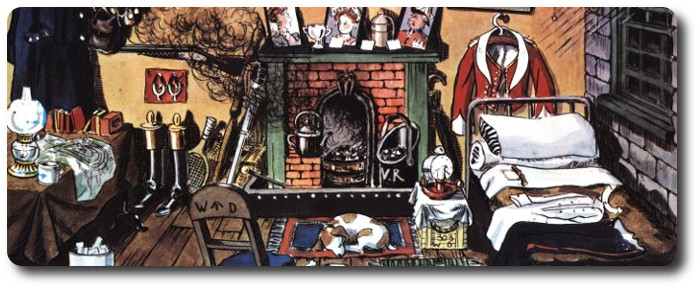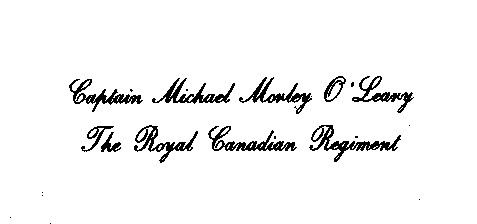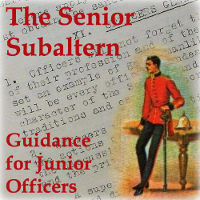
Customs of the Army (1956)
Contents - Sections - I - II - III - IV - V - VI - VII - VIII - IX
SECTION IX
CORRESPONDENCE AND CALLING
1. Private Letters
When writing to a Field or General Officer, not well known to an officer, he should start " Dear General Blank." To a Subaltern or Captain he should start " Dear Blank." To finish a letter addressed to a Senior Officer, " Yours sincerely " should be used, and for an officer of Subaltern's or Captain's rank " Yours ever." The writer does not put his rank after his signature.
When writing to a Senior Officer well known to him, an officer should commence with "Dear General,” or "Dear Major."
It is entirely wrong in private correspondence to address a Senior Officer as "Dear Sir."
Great care should be taken to ensure that the correct decorations and initials are put on the envelope. If not known, these must be discovered from the Army List or some other source.
2. Answering Invitations
Answers to invitations should be sent off as soon as possible. Delay only causes inconvenience and anxiety to the host or hostess, besides upsetting their arrangements.
(a) Private Invitations.
These should be replied to in the form in which they are written. For example, an invitation received commencing "Dear Mr. White" and finishing yours sincerely," should be replied to in the same style-" Dear Mr. (or Mrs.) Black " and ending "Yours sincerely."
(b) Formal Invitations.
There is only one way to reply to a formal invitation and that is by a formal reply.
An invitation in which an officer's company is requested by one, or a number of persons, requires a formal answer in the following style:
"Mr. A. N. Other has much pleasure in accepting the kind invitation of to at (time) on (day or date)
or
"Mr, A. N. Other much regrets that, owing to a previous engagement, he is unable to accept the kind invitation of . . . . "
Neither of the above replies should be signed.
3. Official Correspondence
This subject will be dealt with under the following headings:
(a) Formal letters.
(b) Demi-official (D.O.) letters.
(c) Official letters.
(d) Memoranda
(a) Formal letters.
A junior officer will normally only need to write a fonnal letter when applying for leave or some similar occasion.
The subject is written in block capitals at the head of the letter, which is then written in the following form:
From:
Address:
To:
Date:
Sir, I have the honour to request that . . . . . . .
I have the honour to be, Sir,
Your obedient servant, (Signature)
(Rank)
(Unit)
(b) Demi-official letters.
These letters usually consist of personal correspondence between officers on Service matters, and allow a more informal method of address. They must not be quoted in official correspondence, and they are filed separately.
They are inclined to cause complications because of separate filing, so should be used sparingly.
The officer's rank, name and initials should be put at the head of the page. The rest of the letter is in normal social letter form, with the reference number under the address and the addressee's rank, initials, name, decorations, and address below the body of the letter on the left-hand side.
(c) Official letters.
These are the normal everyday letters dealing with Service matters, and they take the following form:
Address
Telephone No.
Reference No.
Date
To:
Subject: I.
Signature
Rank
Appointment
NOTES.
(i) Security classification, where applicable, is placed in blocks above the address in the top right-hand corner.
(ii) Paragraphs should be numbered.
(iii) The initials of the officer drafting the letter, and the typist, may be put in the bottom left-hand corner.
(iv) Copies to individuals or branches for information come at the end of the letter after the signature.
(d) Memoranda (memos).
These are official letters or notes within the unit or establishment, and may be quite brief. They should take the following form:
Reference No
Date
To:
Subject:
Signature
Rank
Station.
Appointment
4. Signing letters
Under no circumstances should an officer sign any letter or document without first reading and under- standing the contents, and also satisfying himself that the contents are correct and accurate.
5. Dating Signatures
When an officer has any correspondence typed for him he should tell the clerk to leave the date blank. On signing the document, the officer should put in the date.
This applies to any document which an officer may sign or initial, and the date is that on which the document is signed.
6. Adding Regiment or Corps
When signing official correspondence an officer should put his regiment or corps after his signature.
When addressing any correspondence to an officer of the Royal Navy, Royal Air Force, Royal Marines, Royal Artillery, or Royal Engineers, it is customary to put the initials of the Service or corps after the name and decorations of the addressee, e.g.,
Commander A. Broadside, D.S.O., D.S.C., R.N.;
or
Captain T. O. Morrow, R.A.
7. General
The best guide as to which form of letter should be used when writing a reply is to reply in the same form as the original.
(a) Official letters.
These are the normal everyday letters dealing with Service matters, and they take the following form: Address Telephone No. Reference No. Date To: Subject: Signature Rank Appointment
NOTES.
(i) Security classification, where applicable, is placed in blocks above the address in the top right-hand corner.
(ii) Paragraphs should be numbered.
(iii) The initials of the officer drafting the letter, and the typist, may be put in the bottom left-hand comer.
(iv) Copies to individuals or branches for information come at the end of the letter after the signature.
(b) Memoranda (memos).
These are official letters or notes within the unit or establishment, and may be quite brief. They should take the following form:
8. Calling
(a) General policy.
Calling is an old social custom which ensured that members of the garrison and/or community met each other, especially when a regiment or unit first arrived in a district.
It died out almost completely during the late war, and at present there are few military stations where it is practised to any great extent. This does not mean that the young officer will not have to do it.
On first arriving in a unit the officer should find out from the Adjutant whether or not it is the custom to call.
(b) Visiting Cards.
Regiments may have their own type of visiting card, but the most customary one is as shown.

The card should have engraved on it the officer's rank "Mr." in the case of a Subaltern), name, and initials, his regiment, and if a member of a London club, the name of that club.
The writing must be engraved, and not printed, and should be in copperplate. Under no circum- stances should decorations or degrees be shown.
(c) People on Whom to call.
It is the normal custom for an officer on joining any unit to call on the Mess and the married officers. He should call on the G.O.C. of the station, going in uniform and writing his name in the book. Then he should call on the other Messes in the station and the C.Os. of other units.
Other calls are dependent on the custom of the station and on the officer's own discretion. On joining, the officer should find out on whom to call and should do it as soon as possible.
(d) Calling on a Mess.
When calling on a Mess an officer should take with him two cards. On one he should write the name of the Commanding Officer and the regiment, i.e.:
Lieut.-Colonel D. Blank, C.B., D.S.O.,
Commanding 1st Bn. The Blankshire Regiment.
On the second one he should write:
The Officers, - 1st Bn. The Blankshire Regiment.
(e) Calling for the Regiment or Unit.
When a regiment or unit first arrives in a new station it is normally the custom for the officers to call on other Messes and senior officers and civilians on behalf of the regiment or unit.
In this case, two officers usually go out together and they should take with them two regimental cards, and their own. The regimental cards should have the following particulars on them:-
On one:
Lieut.-Colonel A. B. Snooks, Commanding 1st Bn. The Blankshire Regiment.
On the other:
The Officers, 1st Bn. The Blankshire Regiment.
(f) Calling when attached.
When attached to another unit for training, or to a school for a course, besides calling on the Mess or Permanent Staff Mess on arrival, the officer should call on the Commanding Officer and his Company or Squadron Commander, or equivalent, if they are married.
The two cards mentioned in sub-para. (d) should be left in the Mess.
(g) p.p.c. Cards.
On leaving a station an officer should call on those people and Messes on whom he called on arrival, and leave his card marked “p.p.c." in one corner. “p.p.c." stands for . . . .pour prendre conge."
(h) Official entertainments.
It is customary to call on the host or hosts after attending an “official" dinner or dance. This should be done the next day if possible.
Customs of the Army (1956)
Contents - Sections - I - II - III - IV - V - VI - VII - VIII - IX
- The O'Leary Collection; Medals of The Royal Canadian Regiment.
- Researching Canadian Soldiers of the First World War
- Researching The Royal Canadian Regiment
- The RCR in the First World War
- Badges of The RCR
- The Senior Subaltern
- The Minute Book (blog)
- Rogue Papers
- Tactical Primers
- The Regimental Library
- Battle Honours
- Perpetuation of the CEF
- A Miscellany
- Quotes
- The Frontenac Times
- Site Map
QUICK LINKS

- The Senior Subaltern
- Staff Duties and the Young Officer
- How to Write Effective English
- Notes and Quotes - Staff Duties
- Advice to Officers (1782)
- Mess Rules of the Infantry School (1884)
- A Dozen Military Epigrams (1901)
- How The Loafer's Bred (1904)
- The Promotion and Examination of Army Officers (1904)
- A Few Tips for Officers, Before and After Joining (1906)
- Standing Orders of The RCR (1910)
- Standing Rules for Officers' Messes of The RCR (1913)
- The Young Officer's Guide to Knowledge (1915)
- The Duties of an Officer (1916)
- An Open Letter to the Very Young Officer (1917)
- Advice to a Young Officer (1917)
- Battalion Duties; Officers, NCOs, and Soldiers (1917)
- Pleasing Infantry Brigadiers (1917)
- Role and the Responsibilities of the CO in a Battalion Mess (1917)
- The RCR, "A" Company Standing Orders (1918)
- Some Staff Duties (1923)
- An Officer's Code (1925)
- Hints on Promotion Exams (1925)
- On Writing Appreciations (1926)
- The RCR; Rules for Officers' Messes (1927)
- Morale And Leadership (1929)
- RCSI Hints for Young Officers (1931)
- RCSI Notes on Drill (1931)
- The Study of War by Junior Officers (1932)
- Self-Training (1934)
- "The Problem of the First Ten Years" (1934)
- Standing Orders of The RCR; 1935)
- Customs of the Service (1939)
- Drill and Discipline (1939)
- Leaders Win Where Commanders Lose (1939)
- The Officer and Fighting Efficiency (1940)
- Officers' Mess (RCAF, 1940)
- The Duties of an Officer (1942)
- Comrades in Arms (1942)
- Example Standing Orders - Subalterns (1942)
- Hints for Newly Commissioned Officers (1943)
- Completed Staff Work (1943)
- FOLLOW-ship (1943)
- Hints for Junior Officers (1945)
- Officer-Like Qualities (1948)
- Military Writing (1948)
- An Analysis of the Sub-Unit Commander (1949)
- Leadership (1950)
- Neptune's Notes (undated, 1950s-60s)
- Thinking and Writing (1953)
- Examination Tactics (1953)
- Officers (1954)
- On Writing Examinations (1954)
- Customs of the Army (1956)
- 1st Bn, The RCR, Senior Subaltern (1956)
- Pigs Have Wings (1960)
- Leadership and Man Management (1960)
- Officers (1964)
- 1RCR - The Sergeants' Mess - "Tips" (1971)
- 2RCR Junior Officer's Handbook (1973)
- How to be a Successful Subaltern (1978)
- Foreword to the Infantry Journal, No. 8 (1979)
- Do You Appreciate the Finer Points of Life? (1980)
- The RCR Regimental Standing Orders - Senior Subaltern (1992)
- Infantry Company Command (2016)
- A Miscellany of Advice for Subalterns
- The Young Officer and the NCO - Quotes